In a recent study published by Dangerous by Design 2014, South Florida, including the Florida Keys is the fourth most dangerous area in the entire country for pedestrians.
Between 2003 and 2012, over 47,000 pedestrians were killed in traffic-related accidents. The top 3 worst areas for pedestrians are New York, Los Angeles, and South Florida, which alone accounts for 1,539 pedestrian fatalities.
The Pedestrian Danger Index (PDI) is an indicator which measures the likelihood of being killed as a pedestrian along major roadways. The index is based on the amount of pedestrian deaths per 100,000 residents and percentage of people who commute on foot. The national average for the PDI is 52.2. South Florida’s score was 145.33.
Leesfield & Partners was recently involved in a pedestrian case involving a small child crossing the street who was ran over by a distracted driver. While there is a lot to say about creating and improving upon safety designs for pedestrians, creating safer crosswalks, or increasing the criminal punishment to those found guilty of traffic homicide, driver behaviors have been slow to change.
The National Highway Traffic Safety Administration recently published a list of safety reminders for pedestrians and motorists:
For Pedestrians:
-Walk on a sidewalk or path whenever one is available.
-If there is no sidewalk or path available, walk facing traffic (on the left side of the road) on the shoulder, as far away from traffic as possible. Keep alert at all times; don’t be distracted by electronic devices, including radios, smart phones and other devices that take your eyes (and ears) off the road environment.
-Be cautious night and day when sharing the road with vehicles. Never assume a driver sees you (he or she could be distracted, under the influence of alcohol and/or drugs, or just not seeing you). Try to make eye contact with drivers as they approach you to make sure you are seen.
-Be predictable as a pedestrian. Cross streets at crosswalks or intersections whenever possible. This is where drivers expect pedestrians.
-If a crosswalk or intersection is not available, locate a well-lit area, wait for a gap in traffic that allows you enough time to cross safely, and continue to watch for traffic as you cross.
-Stay off of freeways, restricted-access highways and other pedestrian-prohibited roadways.
-Be visible at all times. Wear bright clothing during the day, and wear reflective materials or use a flash light at night.
-Avoid alcohol and drugs when walking; they impair your abilities and judgment too.
For Drivers:
-Look out for pedestrians everywhere, at all times. Very often pedestrians are not walking where they should be.
-Be especially vigilant for pedestrians in hard-to-see conditions, such as nighttime or in bad weather.
-Slowdown and be prepared to stop when turning or otherwise entering a crosswalk.
-Always stop for pedestrians in crosswalks and stop well back from the crosswalk to give other vehicles an opportunity to see the crossing pedestrians so they can stop too.
-Never pass vehicles stopped at a crosswalk. They are stopped to allow pedestrians to cross the street.
-Never drive under the influence of alcohol and/or drugs.
-Follow the speed limit, especially around pedestrians.
-Follow slower speed limits in school zones and in neighborhoods where there are children present
Click here to read more about pedestrian safety and our firm’s past verdicts and settlements.
 Key West Injury Lawyer Blog
Key West Injury Lawyer Blog



